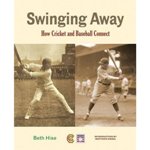Swinging Away: How Cricket and Baseball Connect
Martin Chandler |Published: 2010
Pages: 192
Author: Hise, Beth
Publisher: Scala Publishers Ltd
Rating: 4 stars

In common with the majority of cricket fans I have little knowledge of baseball and I have no doubt that the average baseball enthusiast has no appreciation of our great game. That said the two sports clearly have similarities and it is perhaps surprising therefore that the sort of exercise that Beth Hise undertakes here has not been carried out before*. There has been a recent book by a cricketer, former England batsman Ed Smith, looking at the two sports in the context of his experience of playing both, but that book is very different from this, essentially historical work.
Large parts of the book are occupied with studies of the histories of both games. From a cricketing point of view there is much material available on the game’s past and long and scholarly works have appeared at regular intervals since the 19th century. Beth Hise wisely chooses not to seek to emulate those writers but does provide a concise story of the game’s developement dwelling on some subjects, such as the laws and the equipment, that are particularly relevant to her purpose. The historical aspects are clearly thoroughly researched – cricket historians have disagreed from time to time over some issues and events, and some have on occasions proved previously accepted facts to be incorrect, but as far as I could tell Beth Hise is completely familiar with contemporary views.
Given the accuracy of the history of cricket I have no reason to believe that those sections dealing with the history of baseball are any less accurate. Certainly they are written in a manner that is sympathetic to the reader who begins them, as I did, in complete ignorance of their subject matter. In common, I suspect, with many cricket fans I often lose sight of the fact that other sports have developed in a haphazard way over many years and this book certainly taught me that baseball is a sport, like cricket, that has a rich past full of characters and controversies.
For me the most engrossing part of the book dealt with how baseball has developed in England. I must confess it simply did not occur to me that any serious attempts to play the game here had ever been attempted. In fact there have been a number of touring sides that have visited from the US that created considerable interest, so much so that in the 1890’s and 1930’s there were attempts to set up professional leagues in England. Neither fledgling organisation lasted very long but it was fascinating to learn how the game had gained footholds in the nation’s affections only to be pushed out again. There is still some baseball played in England, particularly it would seem on Humberside, but it is very much a minority sport here now.
The corollary of the story of English baseball is that of American cricket. That is something that has been the subject of several books, at least two of them of very high quality, but scholarly in nature and certainly well away from the mainstream of sports publishing. Again Beth Hise strikes an excellent balance with a thorough but not overly detailed look at the history of the game in America. Unlike English baseball players, who could never seriously compete with their American cousins, a team of cricketers from Philadelphia did briefly, at the height of the golden age, provide a team that, if not quite of Test standard, was good enough to take on and defeat English county sides. The Philadelphian swing bowler Bart King has always been regarded as one of the finest of his type ever to grace the game – such was his prowess with the ball it is often forgotten he was also a fine batsman, and there can be no doubt he was a cricketer of the highest class.
The production standards of the book are exceptional, particularly the many illustrations which appear throughout the text. The reader is immediately struck by the full page photograph, uncaptioned, that appears on the second page. It shows two men in an indoor net one, rather smaller than his pupil, trying to show the other the correct stance for batting. The novice batsman is a burly individual, clearly not in the first flush of youth, wearing a shirt and tie and apparently having all sorts of problems getting to grips with what is being asked of him. Over the page one learns that the coach was Australian Test cricketer Alan Fairfax, and the second man the legendary baseball hitter George Ruth, better known as Babe. In the body of the book it is revealed that despite what the photo suggests the, by then 39 year old Babe showed a great aptitude for batting.
All in all this is a fascinating book that I highly recommend. Its subject matter might not, at first glance, appear to be of the greatest significance but, for the reasons put forward by Matthew Engel in his introduction, which he, his publishers and the MCC have kindly allowed us to reproduce, followers of both sports really should make an effort to better understand each other’s game.
*I am aware of another book that has a similar mission statement to Swinging Away, written by George Kirsch and entitled Cricket and Baseball, that was published by University of Illinois Press in 2007 although, from the admittedly limited knowledge I have of the book, it appears to, unlike Swinging Away, examine the two sports from a purely American standpoint.






Leave a comment